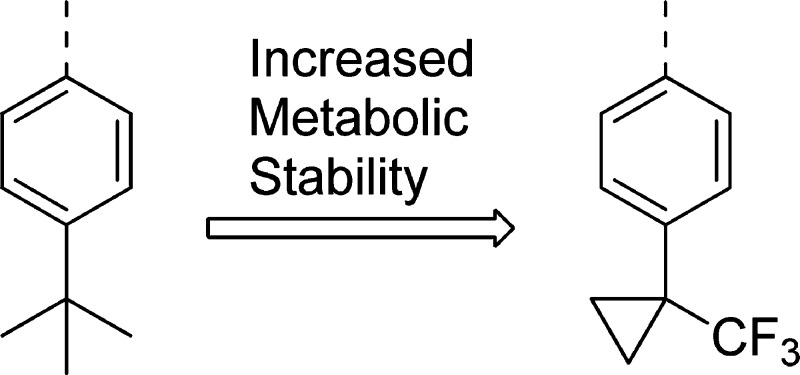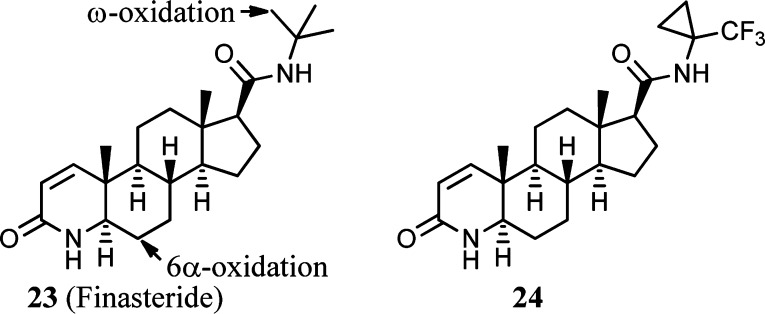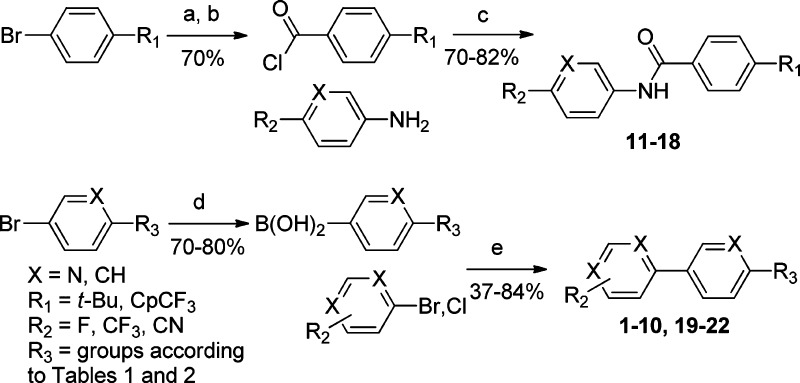Abstract
Susceptibility to metabolism is a common issue with the tert-butyl group on compounds of medicinal interest. We demonstrate an approach of removing all the fully sp3 C–Hs from a tert-butyl group: replacing some C–Hs with C–Fs and increasing the s-character of the remaining C–Hs. This approach gave a trifluoromethylcyclopropyl group, which increased metabolic stability. Trifluoromethylcyclopropyl-containing analogues had consistently higher metabolic stability in vitro and in vivo compared to their tert-butyl-containing counterparts.
Keywords: Metabolic stability, metabolism, clearance, tertiary butyl, tert-butyl, t-butyl
Compounds with high metabolic lability or hepatic clearance often have low oral bioavailability and short half-lives. Consequently, optimization of the metabolic stability of lead molecules is of critical importance in the drug discovery process.1 In vitro studies such as metabolic stability assays in liver microsomes,2 biotransformation studies to pinpoint vulnerable spots in the molecule, and in vivo pharmacokinetic studies in preclinical species are some of the tools employed by project teams to arrive at potent compounds with favorable clearance values. Cytochrome P450s (CYPs) are the principal enzymes considered responsible for hepatic metabolism.3,4
Susceptibility to metabolism is a common issue with the tert-butyl group on compounds of medicinal interest. During the course of a lead optimization effort, we encountered a pocket in a receptor with a strong preference for a tert-butyl group. However, compounds bearing this tert-butyl group had high clearance in rats and microsomal incubations. The general principals and specific functional group used during the course of overcoming this challenge may be employed in other chemical series and are detailed herein.
We hypothesized that the rapid abstraction of H from the sp3 hybridized methyl carbons of the tert-butyl resulted in rapid oxidative metabolism. Compound 1 served as the prototype tert-butyl-containing compound. An in vitro biotransformation study in rat and human liver microsomes (RLM, HLM) showed that the major route of metabolism of 1 is oxidation of the tert-butyl to the corresponding alcohol product 2, confirming the initial hypothesis. Further in vitro studies in human liver microsomes suggested that oxidative metabolism could be attributed to multiple Cytochrome P450 isoform involvement, including CYPs 3A4/5, 2D6, 2C9, and 1A2 (data not shown).
Polar substitution has often been used to increase metabolic stability. As expected, analogues bearing a hydroxyl, 2, cyano, 3, or acid, 4, had increased microsomal stability. However, an oxetane, another group that has recently been reported to improve metabolic stability,5−8 offered no improvement (5 vs 1).
Clearly, in some instances, the introduction of a polar group is not tolerated by the receptor. For such a case, another solution was needed. We hypothesized that removing all fully sp3 C–Hs from the tert-butyl would lower the rate of H-abstraction by metabolizing enzymes. On the basis of this principle, we designed a replacement for tert-butyl that has a similar shape and size and retains hydrophobicity but lacks fully sp3 C–Hs. One of the methyl groups was replaced by CF3. The other two methyl groups were joined to form a cyclopropyl ring, whose C–Hs have a higher homolytic bond dissociation energy owing to the higher s-character of the C–H bonding orbitals than a typical aliphatic C–H. As shown by comparing compounds 1, 6, and 7, the CF3 group alone was not adequate nor was just installing the cyclopropyl group (1 vs 8). However, when both features were combined in the trifluoromethylcyclopropyl9−11 group or Cp-CF3, the resulting compound 9 had high metabolic stability. The LogP of compounds 1 and 9 are 4.2 and 4, respectively. Compound 10 bears the Cp-CF3 and also incorporates a pyridyl-N, which can be useful as a solubilizing functionality.
We sought to probe the consistency of increase in metabolic stability of the Cp-CF3 group compared to tert-butyl. To do so, we tested the metabolic stability of six additional matched pairs of biaryls and amides, where the portion of the compound distal to the tert-butyl or Cp-CF3 contained functionality that was generally relatively metabolically stable. The results are summarized in Table 2 and demonstrate consistent increases in metabolic stability by replacing tert-butyl with Cp-CF3.
Table 2. In Vitro Clearance of Matched Pairs of Compounds Containing Either tert-Butyl or Trifluoromethylcyclopropyl (Cp-CF3).
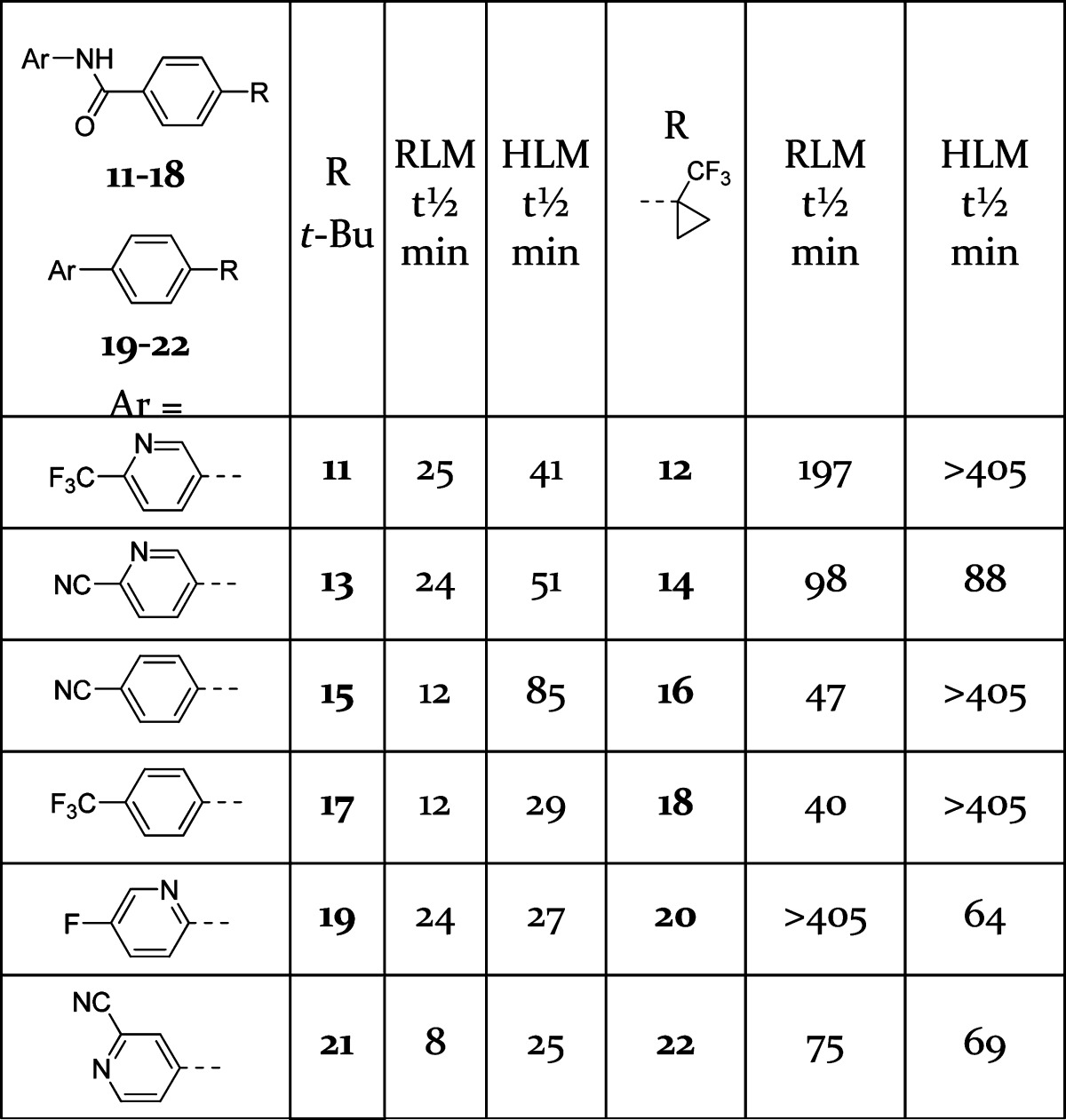
Table 1. In Vitro Clearance of a Series of tert-Butyl Replacements.
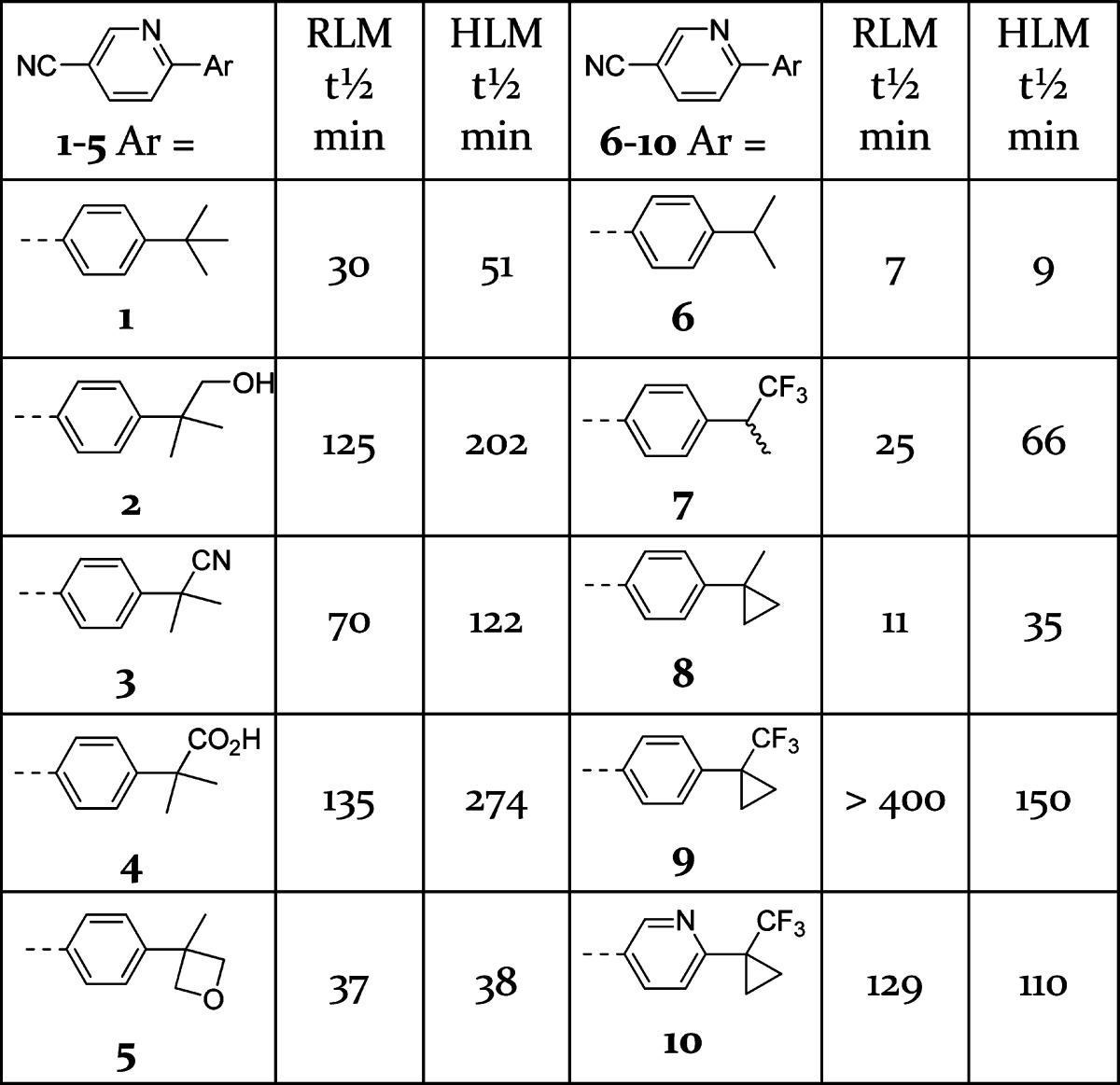
Compounds 1, 5, 6, 9, 11, 12, 19, and 20 were checked for CYP 3A4/5 inhibition with and without a 30 min incubation with NADPH prior to substrate addition as a screen for potential time-dependent inhibition, in order to mitigate against a chance for artifacts in metabolic stability differences due to CYP inhibition. All compounds tested had negligible reversible CYP inhibition (IC50 >50 μM) with no evidence of time-dependent inhibition.
We measured clearance in rats for representative compounds in order to determine if the in vitro clearance comparisons were consistent with in vivo results. The results are summarized in Table 3. Despite the addition of a polar atom, oxetane-containing 5 had similar in vivo clearance to tert-butyl-containing 1, consistent with the lack of in vitro improvement. Cp-CF3-containing 9 and 12 had substantially lower in vivo clearance than their tert-butyl-containing counterparts 1 and 11, respectively.
Table 3. In Vitro and in Vivo Clearance Comparisons.
| compd | RLM Cl (h) (mL/min/kg) | rat Cl (mL/min/kg) | rat t1/2 (h) | rat Vss (L/kg) |
|---|---|---|---|---|
| 5 | 30 | 28 | 0.4 | 1.3 |
| 1 (t-Bu) | 33 | 20 | 2.3 | 2.5 |
| 9 (Cp-CF3) | <5 | 4.6 | 9.1 | 3.4 |
| 11 (t-Bu) | 36 | 352 | 0.2 | 5.4 |
| 12 (Cp-CF3) | 10 | 25 | 3.4 | 6.2 |
Finasteride (23) is known to be metabolized in humans predominantly on the tert-butyl (ω) but also at the 6-position (Figure 1).12,13 Replacing the tert-butyl with Cp-CF3 increased the t1/2 in HLM from 63 min (23) to 114 min (24). This moderate increase is consistent with a caveat of the approach: replacing tert-butyl with Cp-CF3 is not expected to substantially reduce metabolism at distal soft-spots.14 In this case, at least the 6-position can still be metabolically labile.12,13
Figure 1.
Finasteride and the Cp-CF3 analogue thereof.
In conclusion, we have demonstrated an approach of removing all the fully sp3 C–Hs from a tert-butyl group: replacing some H with F and increasing the s-character of the remaining C–Hs. This approach gave a trifluoromethylcyclopropyl group that consistently increased metabolic stability in vitro and in vivo compared to tert-butyl.
Experimental Procedures
The compounds 1–22 were prepared according to Scheme 1.
Scheme 1. General Synthesis of Compounds in Table 1 and 2.
Reagents and conditions: (a) n-BuLi, THF, −78 to 0 °C, CO2; (b) (COCl)2, CH2Cl2; (c) iPr2NEt, CH3CN; (d) n-BuLi, THF, −78 to 0 °C, B(OMe)3; (e) SPhos, Pd(OAc)2, K3PO4, THF.
Arylboronic acids and pinacol esters used to make 1, 3, 4, 6, 19, and 21 are commercially available. Arylboronic acids to make 5(15) and 8(16) are derived from the corresponding arylbromides, which are prepared according to the corresponding references. Compound 4 was converted to the acid chloride with (COCl)2, then reduced to 2 with NaBH4.
Intermediates to make compounds containing Cp-CF3 groups were prepared according to Scheme 2.
Scheme 2. Synthesis of Cp-CF3-Containing Aryl Bromides.
Reagents and conditions: (a) X = CH, MsCl, 18-crown-6, KF, DMF, 100 °C;17 X = N: Tebbe reagent;18 (b) CH2N2;19 (c) Xylenes reflux19.
Acknowledgments
We thank Phong Nguyen for performing CYP reaction phenotyping and for helpful discussion. We further acknowledge George Marsh, Myrtha Durena, Melissa Queliz, and Jaimie Spear for performing in vivo experiments and Danuta Lubicka for formulating compounds for in vivo dosing. We further acknowledge Shari Bickford and Jenny Zhan for performing reversible and time-dependent CYP inhibition experiments. We thank Stephane Rodde for performing LogP determinations.
Glossary
Abbreviations
- CpCF3
trifluoromethylcyclopropyl
- Cl
clearance
- Cyps
cytochrome P450s
- HLM
human liver microsomes
- RLM
rat liver microsomes
- SPhos
dicyclohexyl(2′,6′-dimethoxy-[1,1′-biphenyl]-2-yl)phosphine
- t1/2
half-life
- Vss
volume of distribution
Supporting Information Available
Experimental procedures and spectral characterization data. This material is available free of charge via the Internet at http://pubs.acs.org.
The authors declare no competing financial interest.
Supplementary Material
References
- Lau Y. Y.; Krishna G.; Yumibe N. P.; Grotz D. E.; Sapidou E.; Norton L.; Chu I.; Chen C.; Soares A. D.; Lin C. C. The use of in vitro metabolic stability for rapid selection of compounds in early discovery based on their expected hepatic extraction ratios. Pharm. Res. 2002, 19111606–1610. [DOI] [PubMed] [Google Scholar]
- Obach R. S. Prediction of human clearance of twenty-nine drugs from hepatic microsomal intrinsic clearance data: an examination of in vitro half-life approach and nonspecific binding to microsomes. Drug Metab. Dispos. 1999, 27111350–1359. [PubMed] [Google Scholar]
- Guengerich F. P. Cytochrome P450 and Chemical Toxicology. Chem. Res. Toxicol. 2008, 21170–83. [DOI] [PubMed] [Google Scholar]
- Lu A. Y.; Wang R. W.; Lin J. H. Cytochrome P450 in vitro reaction phenotyping: A re-evaluation of approaches used for P450 isoform identification. Drug Metab. Dispos. 2003, 314345–350. [DOI] [PubMed] [Google Scholar]
- Wuitschik G.; Carreira E. M.; Wagner B.; Fischer H.; Parrilla I.; Schuler F.; Rogers-Evans M.; Muller K. Oxetanes in drug discovery: structural and synthetic insights. J. Med. Chem. 2010, 5383227–3246. [DOI] [PubMed] [Google Scholar]
- Wuitschik G.; Rogers-Evans M.; Buckl A.; Bernasconi M.; Marki M.; Godel T.; Fischer H.; Wagner G.; Parrilla I.; Schuler F.; Schneider J.; Alker A.; Schweizer W. B.; Muller K.; Carreira E. M. Spirocyclic oxetanes: synthesis and properties. Angew. Chem., Int. Ed. 2008, 47244512–4515. [DOI] [PubMed] [Google Scholar]
- Wuitschik G.; Carreira E. M.; Rogers-Evans M.; Muller K. Oxetan-3-one: chemistry and synthesis. Process Chem. Pharm. Ind. 2008, 217–229. [Google Scholar]
- Wuitschik G.; Rogers-Evans M.; Muller K.; Fischer H.; Wagner B.; Schuler F.; Polonnchuk L.; Carreira E. M. Oxetanes as promising modules in drug discovery. Angew. Chem., Int. Ed. 2006, 45467736–7739. [DOI] [PubMed] [Google Scholar]
- In vitro potency comparisons have been published for compounds containing either tert-butyl or Cp-CF3 (refs (9−11)). To the best of our knowledge, there are no reports of using the Cp-CF3 group to increase metabolic stability compared to tert-butyl:Paone D. V.; Nguyen D. N.; Shaw A. W.; Burgey C. S.; Potteiger C. M.; Deng J. Z.; Mosser S. D.; Salvatore C. A.; Yu S.; Roller S.; Kane S. A.; Selnick H. G.; Vacca J. P.; Williams T. M. Orally bioavailable imidazoazepanes as calcitonin gene-related peptide (CGRP) receptor antagonists: Discovery of MK-2918. Bioorg. Med. Chem. Lett. 2011, 2192683–2686. [DOI] [PubMed] [Google Scholar]
- Lee S. H.; Seo H. J.; Lee S.-H.; Jung M. E.; Park J.-H.; Park H.-J.; Yoo J.; Yun H.; Na J.; Kang S. Y.; Song K.-S.; Kim M.-a.; Chang C.-H.; Kim J.; Lee J. Biarylpyrazolyl oxadiazole as potent, selective, orally bioavailable cannabinoid-1 receptor antagonists for the treatment of obesity. J. Med. Chem. 2008, 51227216–7233. [DOI] [PubMed] [Google Scholar]
- Phillips D. J.; Davenport R. J.; Demaude T. A.; Galleway F. P.; Jones M. W.; Knerr L.; Perry B. G.; Ratcliffe A. J. Imidazopyridines as VLA-4 integrin antagonists . Bioorg. Med. Chem. Lett. 2008, 18144146–4149. [DOI] [PubMed] [Google Scholar]
- Lundahl A.; Lennernäs H.; Knutson L.; Bondesson U.; Hedeland M. Identification of finasteride metabolites in human bile and urine by high-performance liquid chromatography/tandem mass spectrometry. Drug Metab. Dispos. 2009, 37102008. [DOI] [PubMed] [Google Scholar]
- Hulin-Curtis S. L.; Petit D.; Figg W. D.; Hsing A. W.; Reichardt J. K. V. Finasteride metabolism and pharmacogenetics: new approaches to personalized prevention of prostate cancer. Future Oncol. 2010, 6121897. [DOI] [PMC free article] [PubMed] [Google Scholar]
- For an example, where a site other than tert-butyl was the primary site of metabolism, replacing the tert-butyl with Cp-CF3 did not improve clearance:Guo C.; McAlpine I.; Zhang J.; Knighton D. D.; Kephart S.; Johnson M. C.; Li H.; Bouzida D.; Yang A.; Dong L.; Marakovits J.; Tikhe J.; Richardson P.; Guo L. C.; Kania R.; Edwards M. P.; Kraynov E.; Christensen J.; Piraino J.; Lee J.; Dagostino E.; Del-Carmen C.; Deng Y.-L.; Smeal T.; Murray B. W. Discovery of pyrroloaminopyrazoles as novel PAK inhibitors. J. Med. Chem. 2012, 55104728–4739. [DOI] [PubMed] [Google Scholar]
- Brodney M. A.Pyridyl piperazines and Their Preparation and Pharmaceutical Compositions, for the Treatment of CNS Disorders or Conditions That Can Be Treated by Serotonin-Mediated Neurotransmission. PCT Int. Appl., 2006000912, 2006.
- Gandon V.; Bertus P.; Szymoniak J. A straightforward synthesis of cyclopropanes from aldehydes and ketones. Eur. J. Org. Chem. 2000, 22, 3713–3719. [Google Scholar]
- Nader B. S.; Cordova J. A.; Reese K. E.; Powell C. L. A Novel Fluoride Ion Mediated Olefination of Electron-Deficient Aryl Ketones by Alkanesulfonyl Halides. J. Org. Chem. 1994, 59102898–2901. [Google Scholar]
- Phillion D. P.; Cleary D. G. Disodium salt of 2-[(dihydroxyphosphinyl)difluoromethyl]propenoic acid: an isopolar and isosteric analog of phosphoenolpyruvate. J. Org. Chem. 1992, 5792763–2764. [Google Scholar]
- Banks B. J.Preparation of 1-aryl-4-cyclopropylpyrazoles as medical and agrochemical parasiticides and pesticides. EP 0933363, 1999. Safety note: diazomethane is an explosion hazard.
Associated Data
This section collects any data citations, data availability statements, or supplementary materials included in this article.



